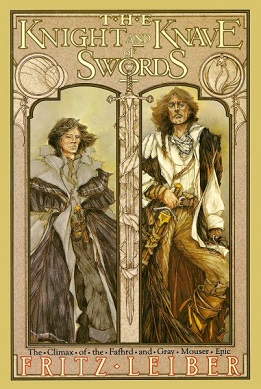A few months ago Centipede Press released volume 7 in their reprint of all of Fritz Leiber’s Fafhrd and Gray Mouser books, The Knight and Knave of Swords. This was the last book in the series that Leiber wrote, originally published on December 20, 1988 by William Morrow. I know this because that 1988 book was my first Leiber hardcover, a review copy that someone gifted to me, with the press release letter still in the book.

I’ve written before about my gradual accumulation of this series in hardcover format. All my other copies were paperback editions, acquired in used bookstores in the late 1980s and early 1990s, when one still could fine those Ace paperbacks in decent shape. So, when Centipede Press announced this series I made it a point to check their website, subscribe to their newsletter, so I could know the exact dates these books were published.
In this book, Centipede Press has outdone themselves. There are, per the publisher, “seven interior illustrations, a full-color frontispiece, two maps, a full color wraparound dustjacket, and illustrated endpapers.” With an introduction by Marc Laidlaw, artwork by Tim Kirk, and bonus material at the end, there’s a lot to absorb and enjoy. It even smells great!

Centipede Press has released both signed and unsigned copies of the book. Mine are of the unsigned variety. Leiber died a few years ago, so those signatures would be a facsimile, and my miserly self isn’t ready to shell out extra coin for the other contributor’s signatures.
If readers (or buyers) are new to this series, then finding the earlier books might prove an expensive endeavor. New from the publisher the cost had been somewhere around $70-$80. On the secondary market, either from dealers or collectors looking to offload books, the cost triples. Centipede Press books tend to fetch a premium on the secondary market, at least for books older than a few years. Supposedly there are two more books announced in this series, per the publisher: “Swords Against the Shadowland by Robin Wayne Bailey and a ninth volume which will be a book of all sorts of Fafhrd and the Gray Mouser archival artwork.” Since, in this case, I got in on the ground floor with volume 1, I’ll go for the last two, as here I might actually a chance for a complete set.
In the meantime, I’m torn between re-reading the stories from my 1988 edition, or gently reading the stories from the new edition. The bonus material is one thing, but spending hours with such a gorgeous book is another thing altogether.